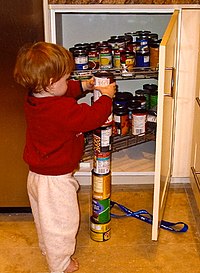
Photo from wikipedia
Purpose Valid and reliable screening tools are needed to improve early detection and optimize developmental outcomes for toddlers at risk for autism spectrum disorder (ASD). The current study aimed to… Click to show full abstract
Purpose Valid and reliable screening tools are needed to improve early detection and optimize developmental outcomes for toddlers at risk for autism spectrum disorder (ASD). The current study aimed to evaluate the utility of the Systematic Observation of Red Flags (SORF) for ASD at 12 months of age in a sample of high-risk infant siblings of children with ASD. Method As part of a prospective, longitudinal study, we examined the sensitivity and specificity of the SORF at 12 months for predicting a diagnosis of ASD at 24 months in a sample of 122 infants, 31 of whom were diagnosed with ASD. Results The optimal SORF Composite cutoff score of 18 correctly identified 24 of the 31 twelve-month-olds who were diagnosed with ASD, yielding a sensitivity of .77 and a specificity of .76. The optimal SORF Red Flags cutoff score of 7 correctly identified 20 of the 31 infants, yielding a sensitivity of .65 and a specificity of .75. Conclusion This preliminary study demonstrates the potential of the SORF as an effective observational screening measure for 12-month-olds at risk for ASD with good discrimination, sensitivity, and specificity.
Journal Title: American journal of speech-language pathology
Year Published: 2021
Link to full text (if available)
Share on Social Media: Sign Up to like & get
recommendations!